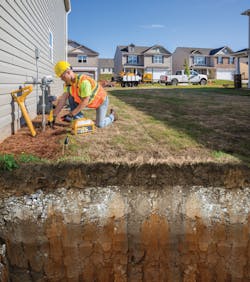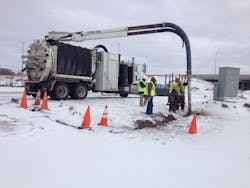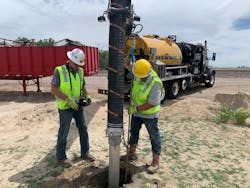There are plenty of choices when it comes to locating technology, according to Daniel Welch, sales manager, Americas, Geophysical Survey Systems, Inc. He says contractors are “most interested in safety, accuracy, speed—in that order,” but advises them to look at “the DNA of a company: are they a specialist with deep expertise?”
But before pulling out the equipment, Welch urges contractors to gather information by talking to the property owner and calling 811. Call the locating company; in fact, some states require it.
Furthermore, “it’s important to understand the site conditions,” he says, “especially with aging infrastructure.” Contractors should walk the site, looking for manhole covers, gas meters, and fire hydrants before choosing the appropriate technology. Welch’s preferred methodology is to start with what’s known and work toward the unknown. “Documentation is scarce sometimes. You might find an unexpected obstruction underground.”
“As cities get older, the maps are less [reliable],” says Mike Reis, vice president of sales, Super Products LLC. “Sometimes you just don’t know what you’ll hit.” To avoid surprises, he says that in Canada, it’s forbidden to dig within 5 feet of a known utility; the work must be done with hydro excavation.
Making the Right Selection
To get the best results in a variety of environments, contractors should choose a locator with multiple frequencies, advises Tim Ross, Application Engineer for Vermeer MV Solutions. “Depending on the type of locator, different frequencies are going to be more beneficial than others.”
Multiple frequency locators allow the operator to adjust the frequency to the type of line they are trying to locate. Locating at a lower frequency reduces the chances that the receiver will pick up a signal from a nearby line, allowing for more accurate locating of the correct line. Multiple frequency locators are ideal for crowded underground conditions.
It's also important to select a utility locator that is durable enough to handle the job site conditions. "Durability is key because contractors take equipment in and out of a truck daily and, unfortunately, the locator may not be handled with absolute care," Ross observes.
Ground conditions can have an impact on the accuracy during passive locating when the operator is doing a general sweep of an area. Ross says passive locating should only be employed at the beginning of a project to scan the job site for utilities where access points are unknown and as a final step after utilities are located to ensure no utilities were missed. For the best results, operators should perform active locating by directly connecting to the utility being located.
Today, electromagnetic technology is the most widely used in the utility industry and is considered a good option for locating buried conductive utilities. Ross says the Vermeer Verifier G3 utility locator is a cost-effective investment that’s user-friendly. “Ground-penetrating radar takes a bit more training to master and is a good option for contractors who need to verify the location of any non-conductive lines.”
Choices
Plastic, iron, and asbestos pipes respond differently to different technology, Welch explains. That said, GPR, an electromagnetic imaging technique commonly used for utility locating and mapping because it allows users to “see” through soil, concrete, ice, and water, has been around for quite a while. The digital revolution took it to another level by making it easier and portable.
“It’s accepted in the industry and it’s more usable for the average contractor,” Welch continues. He says the ultra-portable GSSI UtilityScan also works better in urban settings where space is limited but there are more utilities, creating a large amount of radio interference that can cause difficulties for traditional GPR systems and by overpowering radar.
That’s where GSSI’s patented HyperStacking comes in. “It’s a new way to send and receive energy,” Welch says. HyperStacking uses high-speed interpolated sampling that is less susceptible to urban radio interference to reduce issues like dynamic range limitations, regulatory compliance issues, sample core offset errors, and timing errors, thus producing a clearer picture of the subsurface.
Immune to interference, this technique can reach deeper targets and is effective in conditions that are too “noisy” for traditional systems, which have slower signal observation methods. As a result, Welch says, the utility-locating professional can work with greater confidence in a greater variety of situations. “Radar sends out pulses, but we send out faster signals, and get more back, which enables more advanced filtering. The filter process identifies the signals we want.”
Other options from GSSI include their flagship product, UtilityScan. “It’s small, lightweight, and wireless. It folds up,” Welch lists. It can reach a depth of up to 12 to 15 feet, depending on soil conditions, and provides real-time data.
For applications requiring a deeper reach, GSSI offers the 200 MHz shielded antenna. Capable of going as deep as up to 30 to 40 feet, it’s typically used to locate underground storage tanks, ledge, or areas of contamination.
Hydro Power
Radar and other technologies locate utilities, but, as Reis points out, they only “tell where, but not how far down” the utilities are. Hydro vac excavation allows crews to see the lines after the process of using high-pressure water and an air vacuum system to expose them by cutting through and breaking up soil and removing the resultant slurry.
Even horizontal directional drilling requires crews to locate the depth of the utilities. “They drill a little hole, find the lines, and then they can shoot across—but there are a lot of accidents because the height isn’t known,” Reis explains.
Probably the preferred method of reaching underground utilities, hydro excavation efficiently produces accurate results while minimizing damage to underground pipes, lines, cables, and other structures. "It's fast and it's safe," Reis says, "and it doesn't do any damage." That cuts repair costs, liability costs, and time on the job site.
Owned by the Alamo Group, Super Products has been manufacturing vac trucks for 50 years and continues innovative approaches by working on three sizes. “Smaller trucks are good for urban areas,” Reis acknowledges.
Their hydro-vac trucks were some of the first to have an air package: the 185 CFM system, which is built into the truck and runs off the PTO. "It's an air compressor mounted on the frame rail, wired into the truck," Reis elaborates. "There's no need for a trailer." An added bonus is that air is already onboard for a jackhammer if needed.
Vac trucks were originally used for cleaning spills and sewers. "They were used on only one or two jobs," Reis recalls. "It was very specific. Now they're on every job. What crews used to dig by hand, a vac truck does in a couple of hours."
Beyond Potholing
With more and more utilities being buried, Adam Bates, product manager at Vermeer, urges every contractor to pothole utilities they encounter during a job. He believes that “soft” excavation methods like vacuum excavation are a safer way to do it. “Crews can expose utilities using other digging methods, but there is a greater risk of striking the line they are trying to expose when using shovels, excavators, or backhoes.”
According to Bates, the Vermeer XR2 vacuum excavator addresses a lot of the concerns and limitations that utility contractors have with traditional vacuum excavators. For example, in Canada specifically, road weight restrictions have become a major concern in recent years. Separating liquids and solids on the job allows crews to maintain approximately the same weight leaving the job as when they arrived. The solid material can be stacked and then hauled away separately. It helps keep crews digging holes on the job longer.
Utility applications like potholing and cleaning up horizontal directional drilling slurry have been a natural fit for hydro and air vacuum excavation equipment. However, there are many industries using vacuum excavators to replace more labor-intensive and inefficient methods of working. As Bates says, vacuum excavators aren’t just for utility work anymore.
Air
Although depth is often the key to differentiating utilities, it’s not a safeguard. Thus, many locators incorporate potholing or daylighting to confirm how far the utilities are buried. “That’s where we come in,” says Charles Bell, sales manager, VacMasters. “We check validation.”
Vacuum excavating has been around for about 30 years but has been mostly hydro. By the mid-1990s, air vac excavation was being used. Bell says VacMasters was the first company to manufacture these products on a large scale.
Air vac systems use high-pressure air to break up the soil, which is later used as backfill. “Loose, dry soil is easy to vacuum up,” Bell points out. “The nice thing about air is that you can reuse dry material; it won’t damage the road base or utilities. Hydro uses water, turning the dirt into mud that you have to dump. It can damage utilities.”
An air vac can dig a pothole in five minutes, Bell claims. Other benefits include its smaller package and efficiency, saving time because contractors don't have to carry water to the job site. "One system, one trip, one truck," he sums up. "It's much faster if you don't have to use water. You can quickly verify the accurate location and repair with dry excavation."
Available as either trailer- or truck-mounted equipment, an air vac is a self-contained unit powered by John Deere engineering. Two high-pressure air hoses connect for digging and jackhammering, and a vac hose hooks to the spoils tank to hold the soil.
Suitable for any kind of utility location—electrical conduit, natural gas, oil pipeline, sewer, fiber cable, horizontal directional drilling—air excavation vacuums up the mud and potholes to verify the location of the bore head. “It has multiple uses,” Bell says. “You can clean out catch basins, for example. But it’s mostly used by underground construction firms.”
The technology is ever-evolving. VacMasters is currently adding power and expanding custom options—such as a sandblaster for the oil and gas industry and cathodic protection to remove material down to the bare metal to install protection. The company builds units for Vermeer and Ditch Witch and because they use high-end components, the equipment can be repaired by qualified repair shops.
Technology Plus Operator Skill
Some state regulations mandate the use of vac trucks on job sites. According to Reis, users of vac trucks are “mostly specialty” companies, although he says some contractors get one if they do a lot of utility work. Operation is easily learned in a day, he adds.
The equipment may be easy to learn to operate, but Welch cautions that the user “brings a big chunk of success, based on their experience and expertise.” He says it’s important to pair technology with operator experience for smaller margin of error.
“You need a full toolbox,” Welch states. For him, that includes “GPR, a metal detector, an electromagnetic locator, knowledge of sub-surface conditions—soil and sediment, and knowledge of how the utilities were installed. In New England, for example, water lines must be 5 feet deep.”
Whichever method is used, utility location identifies what's underground, saving time and money and reducing the risk of damaging underground pipes or lines.




